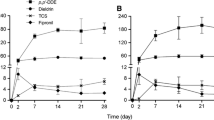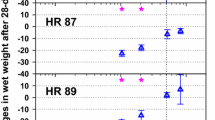Abstract
Purpose
Although ivermectin is a widely used lipophilic parasiticide, data on its potential bioaccumulation in aquatic invertebrates are scarce. In this study, bioaccumulation patterns of radiolabeled 3H-ivermectin from sediments into tissues of the sediment-dwelling worm Lumbriculus variegatus were investigated and assessed.
Materials and methods
Two independent studies are described. In the first study, bioaccumulation kinetics of ivermectin in L. variegatus were investigated by following uptake, elimination, and biotransformation of the compound in worms exposed in artificial sediment. In the second study, possible effects of sediment characteristics on bioavailability of ivermectin were evaluated by comparing accumulation in worms exposed in three different natural sediments and one artificial sediment (organic carbon content 2% to 21%).
Results and discussion
During 28 days of exposure, ivermectin accumulated in worms exposed in all sediments with calculated bioaccumulation factors ranging from 0.2 to 11.0. Bioaccumulation factors correlated with total increase in biomass of worms during the exposure period and with organic carbon content of the sediments. Calculated biota–sediment accumulation factors ranged from 2.1 to 16.6, indicating that other variables, like quality of organic carbon and feeding behavior of the worms, may have influenced the bioavailability of ivermectin. Biotransformation products of ivermectin were only found in water, but not in sediment and worms.
Conclusions
Results show that ivermectin has potential to bioaccumulate in L. variegatus, which could indicate a risk for biomagnification of the compound in the food chain.


Similar content being viewed by others
References
Ankley GT, Benoit DA, Balogh JC, Reynoldson TB, Day KE, Hoke RA (1994) Evaluation of potential confounding factors in sediment toxicity tests with three freshwater benthic invertebrates. Environ Tox Chem 13:627–635
ASTM (American Society for Testing and Materials) (2000) Standard guide for determination of bioaccumulation of sediment-associated contaminants by benthic invertebrates. E1688-00a. In: ASTM 2004 annual book of standards, vol 11.05. Biological Effects and Environmental Fate; Biotechnology; Pesticides. ASTM International, West Conshohocken PA, Philadelphia, PA, pp 1072–1121
Atkinson HJ, Giles GR, MacLean AJ, Wright JR (1958) Chemical methods of soil analysis. Contrib. No 169 (revised), Chem Div, Sci Serv, Canada Department of Agriculture, Ottawa, ON. In: McKeague JA (ed) Manual of soil sampling and methods of analysis. Soil Research Institute, Agriculture Canada, Ottawa
Brust K, Licht O, Hultsch V, Jungmann D, Nagel R (2001) Effects of terbutryn on aufwuchs and Lumbriculus variegatus in artificial indoor streams. Environ Toxicol Chem 20:2000–2007
Contardo-Jara V, Wiegand C (2008) Biotransformation and antioxidant enzymes of Lumbriculus variegatus as biomarkers of contaminated sediment exposure. Chemosphere 70:1879–1888
Contardo-Jara V, Klingelmann E, Wiegand C (2009) Bioaccumulation of glyphosate and its formulation Roundup Ultra in Lumbriculus variegatus and its effects on biotransformation and antioxidant enzymes. Environ Pollut 157:57–63
Cuypers C, Grotenhuis T, Nierop KGJ, Maneiro Franco E, De Jager A, Rulkens W (2002) Amorphous and condensed organic matter domains: the effect of persulfate oxidation on the composition of soil/sediment organic matter. Chemosphere 48:919–931
Davies IM, McHenery JG, Rae GH (1997) Environmental risk from dissolved ivermectin to marine organisms. Aquaculture 158:263–275
Davies IM, Gillibrand PA, McHenery JG, Rae GH (1998) Environmental risk of ivermectin to sediment dwelling organisms. Aquaculture 163:29–46
De Boer J, Smedes F, Wells D, Allan A (1999) Report on the QUASH interlaboratory study on the determination of total-lipid in fish and shellfish. Round 1 SBT-2 Exercise 1000. The EU Standards, Measurements and Testing Program, European Communities, Bruxelles, Luxembourg, 20 pp
Di Toro DM, Zarba CS, Hansen DJ, Berry WJ, Swartz RC, Cowan CE, Pavlou SP, Allen HE, Thomas NA, Paquin PR (1991) Technical basis for establishing sediment quality criteria for nonionic organic chemicals using equilibrium partitioning. Environ Toxicol Chem 10:1541–1583
Drewes CD, Fourtner CR (1989) Hindsight and rapid escape in a freshwater oligochaete. Biol Bull 177:363–371
Duce IR, Scott RH (1985) Actions of dihydroavermectin B1a on insect muscle. Brit J Pharmacol 85:395–401
EC (European Commission) (2003) Technical Guidance Document (TGD) on Risk Assessment in support of Commission Directive 93/67/EEC on Risk Assessment for new notified substances, Commission Regulation (EC) No 1488/94 on Risk Assessment for existing substances, Directive 98/8/EC of the European Parliament and of the Council concerning the placing of biocidal products on the market
EC (European Commission) (2010) Common Implementation Strategy for the Water Framework Directive (2000/60/EC). Technical guidance for deriving environmental quality standards. Draft version 5.0 (Stand: 29/01/2010)
Egeler P, Meller M, Schallnaß HJ, Gilberg D (2005) Validation of a sediment toxicity test with the endobenthic aquatic oligochaete Lumbriculus variegatus by an international ring test. In cooperation with R Nagel and B Karaoglan. Report to the Federal Environmental Agency (Umweltbundesamt Berlin), R&D No: 202 67 429
Egeler P, Gilberg D, Fink G, Duis K (2010) Chronic toxicity of ivermectin to the benthic invertebrates Chironomus riparius and Lumbriculus variegatus. J Soils Sediments 10:368–376
Ewell WS, Gorsuch JW, Kringle RO, Robillard KA, Spiegel RC (1986) Simultaneous evaluation of the acute effects of chemicals on seven aquatic species. Environ Toxicol Chem 5:831–840
Fent K, Looser PW (1995) Bioaccumulation and bioavailability of tributyltin chloride: influence of pH and humic acids. Water Res 29:1631–1637
Halley BA, Jacob TA, Lu AYH (1989) The environmental impact of the use of ivermectin: environmental effects and fate. Chemosphere 18:1543–1563
Ho NFH, Geary TG, Raub TJ, Barsuhn CL, Thompson DP (1990) Biophysical transport properties of the cuticle of Ascaris suum. Mol Biochem Parasitol 41:153–166
Krogh KA, Søeborg T, Brodin B, Halling-Sørensen B (2008) Sorption and mobility of ivermectin in different soils. J Environ Qual 37:2202–2211
Landrum PF (1989) Bioavailability and toxicokinetics of polycyclic aromatic hydrocarbons sorbed to sediments for the amphipod Pontoporeia hoyi. Environ Sci Technol 23:588–595
Liebig M, Fernandez AA, Blübaum-Gronau E, Boxall A, Brinke M, Carbonell G, Egeler P, Fenner K, Fernandez C, Fink G, Garric J, Halling-Sørensen B, Jensen J, Knacker T, Krogh KA, Küster A, Löffler D, Porcel Cots MA, Pope L, Prasse C, Römbke J, Rönnefahrt I, Schneider MK, Schweitzer N, Tarazona J, Ternes T, Traunspurger W, Wehrhan A, Duis K (2010) Environmental risk assessment of ivermectin—a case study. Integr Environ Assess Manag 6(1):567–587
Löffler D, Römbke J, Meller M, Ternes TA (2005) Environmental fate of pharmaceuticals in water/sediment systems. Environ Sci Technol 39:5209–5218
Lyytikäinen M, Pehkonen S, Akkanen J, Leppänen MT, Kukkonen JVK (2007) Bioaccumulation and biotransformation of polycyclic aromatic hydrocarbons during sediment tests with oligochaetes (Lumbriculus variegatus). Environ Toxicol Chem 26:2660–2666
Mäenpää KA, Kukkonen JVK (2006) Bioaccumulation and toxicity of 4-nonylphenol (4-NP) and 4-(2-dodecyl)-benzene sulfonate (LAS) in Lumbriculus variegatus (Oligochaeta) and Chironomus riparius (Insecta). Aquat Toxicol 77:329–338
Mäenpää KA, Sormunen AJ, Kukkonen JVK (2003) Bioaccumulation and toxicity of sediment associated herbicides (ioxynil, pendimethalin, and bentazone) in Lumbriculus variegatus (Oligochaeta) and Chironomus riparius (Insecta). Ecotox Environ Safe 56:398–410
Mäenpää KA, Sorsa K, Lyytikäinen M, Leppänen MT, Kukkonen JVK (2008) Bioaccumulation, sublethal toxicity, and biotransformation of sediment-associated pentachlorophenol in Lumbriculus variegatus (Oligochaeta). Ecotox Environ Safe 69:121–129
Mougin C, Kollmann A, Dubroca J, Ducrot PH, Alvinerie M, Galtier P (2003) Fate of the veterinary medicine ivermectin in soil. Environ Chem Lett 1:131–134
Mount DR, Dawson TD, Burkhard LP (1999) Implications of gut purging for tissue residues determined in bioaccumulation testing of sediment with Lumbriculus variegatus. Environ Toxicol Chem 18:1244–1249
OECD (Organisation for Economic Cooperation and Development) (1992) Guideline for testing of chemicals. Fish, acute toxicity test, No. 203, pp 1–9
OECD (Organisation for Economic Cooperation and Development) (2004) Guideline for testing of chemicals. Sediment–water chironomid toxicity test using spiked sediment, No. 218, pp 1–21
OECD (Organisation for Economic Cooperation and Development) (2007) Guideline for testing of chemicals. Sediment–water Lumbriculus toxicity test using spiked sediment, No. 225, pp 1–31
OECD (Organisation for Economic Cooperation and Development) (2008) Guideline for testing of chemicals. Bioaccumulation in sediment-dwelling benthic oligochaetes, No. 315, pp 1–33
Oppel J, Broll G, Löffler D, Meller M, Römbke J, Ternes T (2004) Leaching behaviour of pharmaceuticals in soil-testing-systems: a part of an environmental risk assessment for groundwater protection. Sci Total Environ 328:265–273
Opperhuizen A, Van der Velde EW, Gobas FAPC, Liem DAK, Van der Steen JMD (1985) Relationship between bioconcentration in fish and steric factors of hydrophobic chemicals. Chemosphere 14:1871–1896
Parrish CC (1999) Determination of total lipid, lipid classes, and fatty acids in aquatic samples. In: Arts MT, Weinmann BC (eds) Lipids in freshwater ecosystems. Springer-Verlag, New York, pp 4–20
Prasse C, Löffler D, Ternes T (2009) Environmental fate of the anthelmintic ivermectin in an aerobic sediment/water system. Chemosphere 77:1321–1325
Ristola T, Pellinen J, Ruokolainen M, Kostamo A, Kukkonen JVK (1999) Effect of sediment type, feeding level, and larval density on growth and development of a midge (Chironomus riparius). Environ Toxicol Chem 18:756–764
Sanderson H, Laird B, Pope L, Brain R, Wilson C, Johnson D, Bryning G, Peregrine AS, Boxall A, Solomon KR (2007) Assessment of the environmental fate of ivermectin in aquatic mesocosms. Aquat Toxicol 85:229–240
Suedel BC, Rodger GK (1993) Development of formulated reference sediments for freshwater and estuarine sediment testing. Environ Toxicol Chem 13:1163–1175
US Environmental Protection Agency (US EPA) (2000) Methods for measuring the toxicity and bioaccumulation of sediment-associated contaminants with freshwater invertebrates. EPA 600/R-99/064, pp 63–71
US Food and Drug Administration (US FDA) (1990) IVOMEC1 (ivermectin) pour-on for cattle. Environmental assessment. NADA 140-841. Available from: www.fda.gov/downloads/AnimalVeterinary/Development/ApprovalProcess/EnvironmentalAssessments/UCM072241.pdf
Van den Heuvel WJA, Forbis AD, Halley BA, Ku CC, Jacob TA, Wislocki PG (1996) Bioconcentration and depuration of avermectin B1a in the bluegill sunfish. Environ Toxicol Chem 15:2263–2266
Verrengia Guerrero NR, Taylor MG, Davies NA, Lawrence MAM, Edwards PA, Simkiss K, Wider EA (2002) Evidence of differences in the biotransformation of organic contaminants in three species of freshwater invertebrates. Environ Pollut 117:523–530
You J, Brennan A, Lydy MJ (2009) Bioavailability and biotransformation of sediment-associated pyrethroid insecticides in Lumbriculus variegatus. Chemosphere 75:1477–1482
Acknowledgements
The authors thank Karen Duis for her helpful comments on the manuscript. The studies were performed within the EU projects Keybioeffects (MRTN-CT-2006-035695), MODELKEY (511237-GOCE), and ERAPharm (SSPI-CT-2003-511135) of the 6th Framework Program, and project 214545 by the Academy of Finland.
Author information
Authors and Affiliations
Corresponding author
Additional information
Responsible editor: Henner Hollert
Rights and permissions
About this article
Cite this article
Slootweg, T., Alvinerie, M., Egeler, P. et al. Bioaccumulation of ivermectin from natural and artificial sediments in the benthic organism Lumbriculus variegatus . J Soils Sediments 10, 1611–1622 (2010). https://doi.org/10.1007/s11368-010-0294-3
Received:
Accepted:
Published:
Issue Date:
DOI: https://doi.org/10.1007/s11368-010-0294-3




